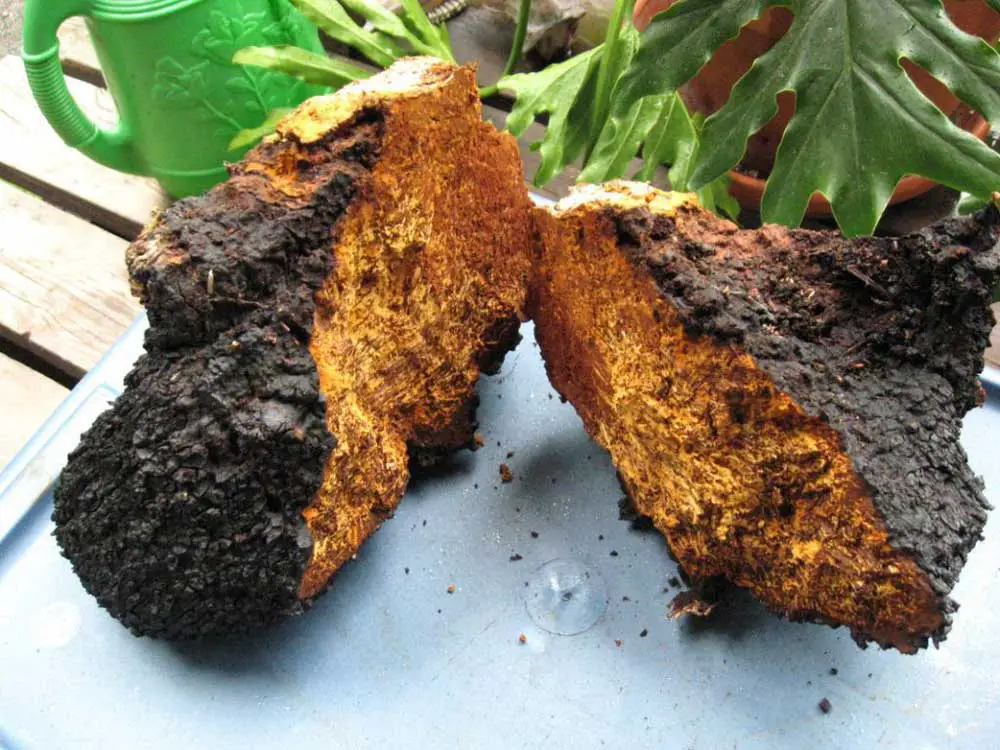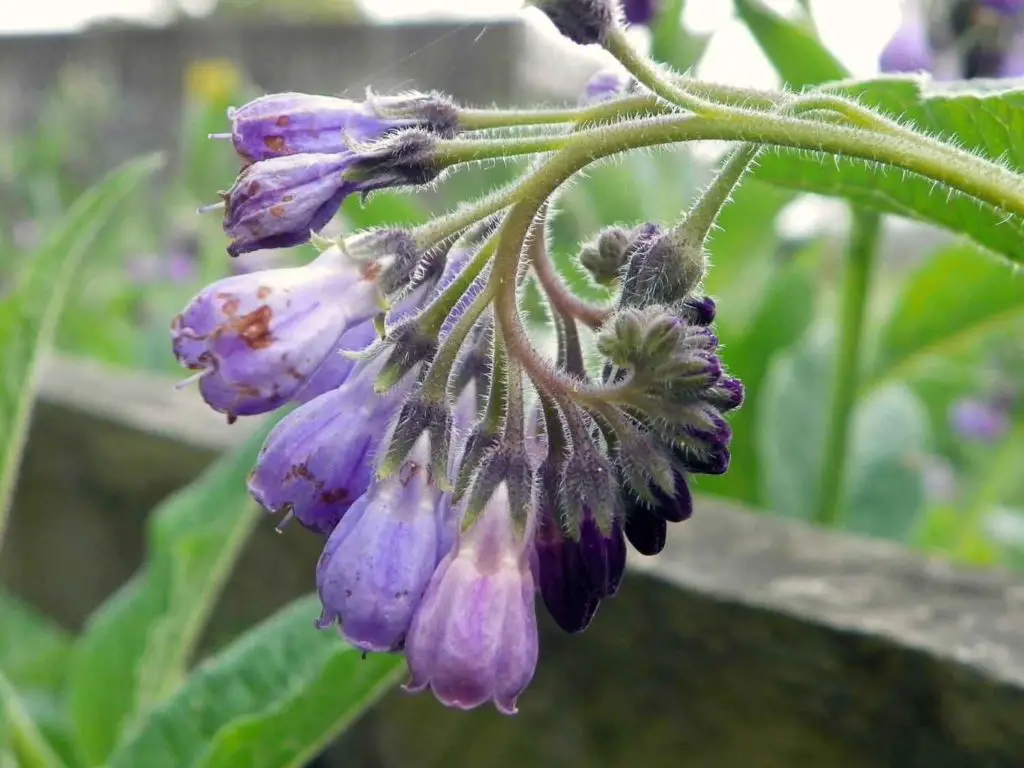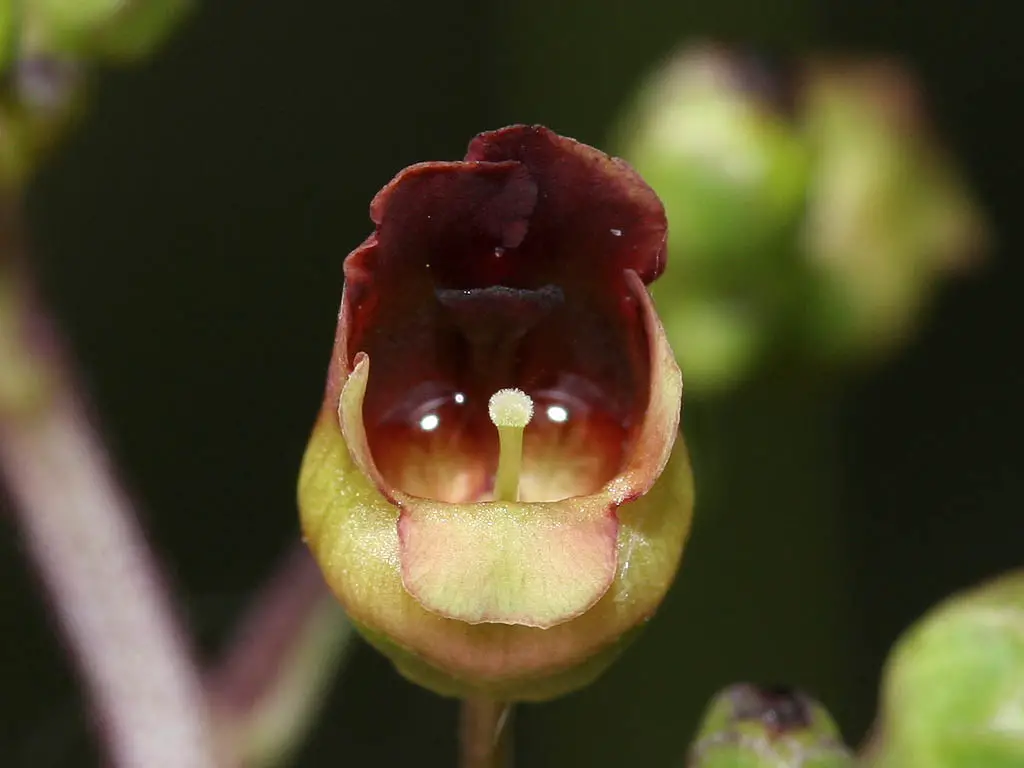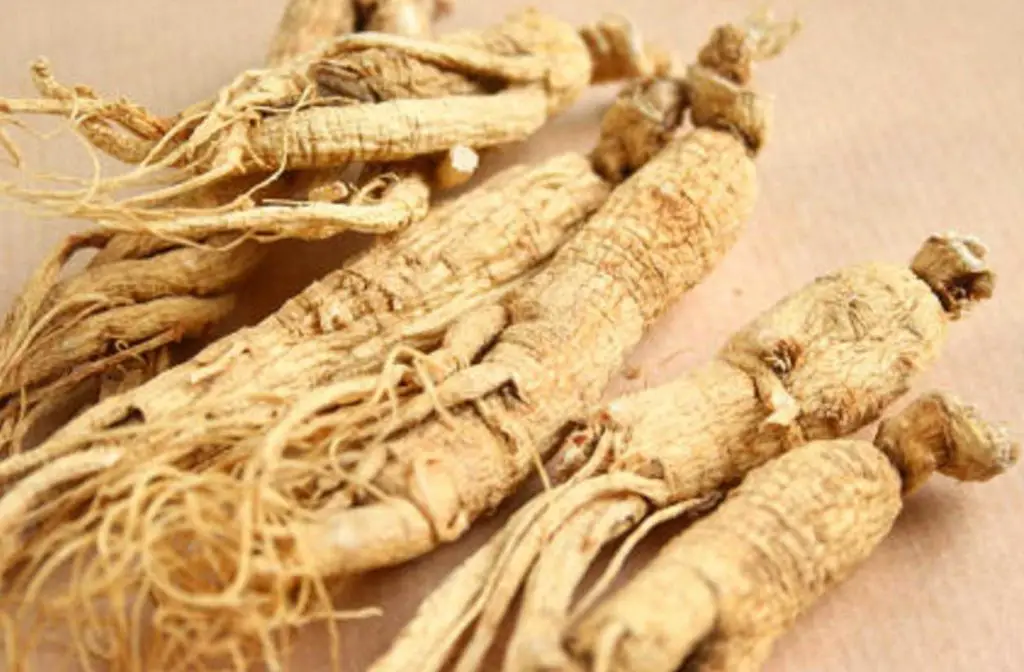What is Chaga Mushroom?
Chaga (Inonotus obliquus), Inonotus means “fibrous” and “earlike”, while obliquus means “slanted.” Common vernacular names include chaga/tchaga/gaga (Russia); hua jie kong jun/bai hua rong (China); kabanoanatake (Japan); pakuri (Finland), clinker polypore, birch conk, birch fungus, birch lip, and birch canker polypore. For the sake of simplicity, this article will use the term Chaga for the remainder of the article. Chaga is one of the top 3 Medicinal Mushrooms in terms of popularity and use. It consistently makes the list of the best fungi in existence.
Where does Chaga Mushroom Grow?
Chaga is a parasitic fungus that grows almost exclusively on standing, living birch (Betula) trees. It is less commonly found on alder, witchen, and bird cherry. It thrives in cold habitats, such as Russia, Western Siberia, Poland, Belarus, China, Japan, Korea, Northern Europe, and northern North America (including Alaska) at latitudes of 45⁰N-68⁰N. It can tolerate temperatures down to -40⁰C.
The sterile conk (non-reproductive canker-like visible growth, comprised of the mycelia) is black, or nearly black, due to its high melanin content, and as such resembles the remains of charred wood. The interior flesh is yellow or yellow-brown with a corky texture. It is irregular in shape and reaches sizes of 0.5-1.5 meters in length, 10-15cm thick, and 5kg or more in weight. The visible exterior is very hard, dense, and deeply cracked. A hammer or axe is generally required to separate the specimen from the host tree.
The host tree becomes infected by the Chaga spore via the air through scars or openings on the trunk (frost damage, broken branches, etc.). The spore of Chaga embeds in the heartwood of the tree, and eventually the visible canker appears external to the trunk and continues developing over the course of many years. The life cycle of the Chaga mushroom is very long and specimens grow very slowly: the typical period from initial infection of the tree host to the time of tree death is about 20 years or more. The mycelium (the visible black canker) is visible on the exterior of the trunk about 4 years after the initial infection. In a forest setting, it is common for Chaga specimens to be present on only one birch tree per thousand trees.
Chaga Mushroom Benefits and Uses
Antioxidant
Chaga has very high antioxidant properties, and the effect of chaga in this regard is similar to that of Vitamins C and E. The melanin content of chaga (responsible for its black exterior color) is responsible for its strong antioxidant capacity, ability to eliminate free radicals, and genoprotective activity. Fungal melanins such as those from chaga decrease genotoxic (damaging to genes) effects of carcinogenic substances, preventing DNA damage and increasing the rate of DNA repair.
Cancer
In an animal model of lung cancer, mice were administered Chaga extract @ 6mg/kg/day for 3 weeks (calculated as the daily intake of a tea infusion in traditional Japanese preparation). In mice with tumors, there was a 60% tumor reduction, and in the metastatic mice, there was a 25% reduction in nodules compared to the control group. Several studies have demonstrated that chaga suppresses proliferation (cancer cell growth) and induces apoptosis (programmed cancer cell death). Chaga also has an indirect effect on cancer by boosting immune system response mechanisms. Chaga is seen useful as a general cancer preventative and is also used in early stage cancer in Russia. In later stage cancers, it is used to mitigate side effects of conventional cancer treatments, and it has a general tone-increasing and pain-relieving action. In patients with incurable stage III – IV cancer, a 3-4 week chaga administration decreased pain to the point where narcotics could be stopped. For general applications in cancer care, Russian clinicians recommend chaga use for at least one year.
Immune Boosting
Chaga balances the immune system, increasing deficient immune responses while decreasing overactive immune responses (these are adaptogenic qualities). It has strong anti-inflammatory properties. In conjunction with other herbs, it has been used to reduce inflammation of the nasal passages and assist with breathing. It benefits periodontitis, eczema, dermatitis, and psoriasis, all auto-immune disorders that are balanced by the immunomodulating effects of chaga. Ulcers and gastritis are also improved by chaga. Chaga essentially encourages and enables the body to self-heal.
Antibiotic
Chaga, along with other medicinal fungi, is being explored as a potential treatment for antibiotic-resistant bacterial infections. Chaga interferes with harmful bacteria’s quorum sensing, the means by which bacteria communicate with each other and gain a foothold in the body. Chaga interferes with this process, thereby giving our own immune system more opportunity to fight the infection.
Diabetes
In animal studies, Chaga has been shown to have strong hypoglycemic activity in mice with diabetes, with sustained hypoglycemic effects lasting up to 48 hours. Another study demonstrated that a pharmaceutical-grade water extract combining chaga with Cordyceps militaris had a beneficial effect against type 1 and type 2 diabetes without causing adverse effects. Chaga has a protective effect on the pancreas, liver, and kidneys in diabetic mice.
Cardiovascular
Chaga has been shown in mice to increase myocardial contractility (the contracting of the heart to pump blood) and calms the rhythm of the heart.
Blood Clots
The Anti-thrombotic nature of Chaga prevents and slows down blood clotting. The ethanol (alcohol) extract of chaga demonstrated the highest platelet aggregation inhibitory activity of 55 medicinal mushrooms tested.
Endurance
Chaga tea (a decoction) has traditionally been used by hunters and foresters to bolster energy, increase work ability, and lessen hunger and tiredness.
Agricultural and Animal Husbandry
Chaga, in the feed of pigs, increases growth and weight gain in piglets. It has also been used to stimulate plant growth similar to the use of fertilizer.
Historical, Traditional and Anecdotal Uses of Chaga
Traditionally, Chaga has been a common folk medicine in Russia, Poland, and the Baltic countries and has documented use since at least the 16th century. It has been and continues to be used for cancer prophylaxis (prevention), early stage gastrointestinal cancer (colon, rectal), breast cancer, skin cancer, gastritis, ulcers, cardiovascular disease, worms, liver disease, diabetes and internal cleansing. Though there are marketing claims that Chaga has been used for thousands of years in China, there are in fact no verifiable written claims of usage until 16th century Russia.
Traditional cultures from around the world all provide historical context for the use of this fungus. The Khanty/Ostyak of Western Siberia (also the source of the name Chaga) used the tea to prevent general disease, to treat parasitic worms, and to improve tuberculosis. The Khanty also used Chaga to create ‘soap water,’ made by smoldering a Chaga specimen in a fire and then stirring it in hot water until it dissolved. This water has a strong disinfecting quality, and was used by women after childbirth and during menstruation to wash their genitals. The Ainu people of Japan smoked powdered Chaga during religious ceremonies. The Woodland Cree of Canada used the yellow-brown inside of the Chaga specimen to build campfires, as it remains smoldering after it catches (called a ‘tinder cork’). The Russian duke Vladimir Monomakh was cured of lip cancer by using Chaga, according to legend.
Chaga Mushroom Side Effects, Warnings and Safety
Chaga is considered to be very safe and well tolerated. The LD50 (median lethal dosage) for mice is 6.5 grams per kilogram of body weight. A test in rats and rabbits showed that daily administration of 0.3-1 grams per kilogram of body weight for 5-6 months had no observed adverse effects. The safety of chaga preparations in therapeutic dosages in humans has been confirmed via clinical studies involving continuous, multi-year administration of patients with cancer and ulcers.
Even though wild-harvested specimens are the ideal source of Chaga, radioactivity and heavy metal accumulation are real concerns. Mushrooms can accumulate heavy metals and pollution from the surrounding environment, so it is important to go deep into the woods to find specimens that are far from roads and factories. Professional, certified producers take extra steps to ensure heavy metals and other contaminants are identified and removed from the final product.
Since the Fukushima nuclear accident in Japan following the 2011 earthquake, there is legitimate concern that the east-west winds of the jet stream have carried radioactivity to North America, contaminating the chaga supply (among other wild plants and fungi). While it is possible to obtain safe chaga specimens, it is wise to test North American chaga for radioactivity prior to processing or consumption. Ensure that North American-sourced chaga products are free from radioactive contamination by contacting the supplier and asking for their certificate of analysis. Relatedly, you may see some concern expressed about the Chernobyl disaster in 1986, and how it spread radiation through the chaga-source forests of Russia and China. While there may have been legitimate concern in the past regarding radioactive contamination from Chernobyl, it is commonly accepted that birch trees from this period have mostly died in the course of their natural life cycles. Therefore, it is safe to assume that the current Russia/China chaga supply is unaffected by Chernobyl radiation.
Chaga Mushroom Dosage
Though dual-extracted products are superior to “hot water only” extracts (teas), the traditional water preparation is 1-2 grams or one tablespoon of crushed mushroom taken as a tea 3x per day. The Siberian Khanty used a 3cm cubed piece of chaga per 2.5L of water.
For quality dual-extracted chaga supplements, the general dosage is 1-2 grams per day.
There is some evidence that “less is more” when it comes to chaga – extracts are most effective at small dosages, as higher doses may produce the opposite biological effect than what was intended.
Because of the immunomodulation/balancing effect, those taking immune-enhancing or immunosuppressive drugs should avoid chaga, as it may affect the action of the pharmaceutical. Similarly, those taking blood thinners (such as warfarin), and those on anti-diabetic medication should avoid chaga or be especially cautious, as chaga can react synergistically with these medications and create a hyperbolic effect in the body.
Since there are no studies on chaga use in pregnancy, it is best to be avoided by pregnant and lactating women.
Sources of Chaga Mushroom: Wild-harvesting and Cultivation
Cultivation
Artificial cultivation of chaga has been attempted; however the final product’s active therapeutic constituents are drastically different from those of wild specimens. In the wild, chaga is exposed to many environmental and biological stressors (such as cold and pathogenic microbes) which in turn stimulate the production of the secondary metabolites that hold the medicinal value for humans. In fact, the harsher the natural environment, the stronger the medicinal value of the chaga specimen. In the absence of these natural stressors, such as in a carefully controlled cultivation setting, it has been demonstrated that secondary metabolites will not develop as robustly as in the wild specimens. Some secondary metabolite pathways that contribute synergistically to the medicinal value of the plant are not present at all in cultivated specimens, leading to a loss of therapeutic value. Experiments and research on developing therapeutically viable chaga via cultivation are currently underway. As commercial demand for chaga increases, it will be important to develop sustainable methods of cultivation, so as not to overharvest the natural supply.
Wild-harvesting
Given the challenges to cultivating chaga, wild-harvesting is the primary source for all chaga supplements. Chaga must be collected from living trees; once the tree dies, so does the chaga specimen, and therapeutic constituents degrade rapidly. The ideal time to harvest chaga is in the fall, after there have been 20 continuous nights where the temperature falls below 5⁰C (41⁰F), as this ensures that the host tree has gone dormant for the winter and therefore the chaga specimen will contain its peak nutrient values.
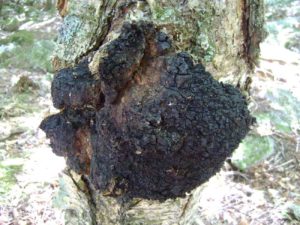
During the summer and when the sap is running, the chaga specimen can contain as much as 80% water content and will therefore be less therapeutically concentrated. Removing the chaga sclerotia (the black canker) from the tree does not kill the tree or eliminate the chaga infection from the host tree, as the fungus is established in the core of the tree. A good rule of thumb: if when placing the hand over the specimen any part of your hand touches the tree, leave the specimen to grow for another couple of years.
Buying Chaga Mushroom
Because of their complex and varying nature, mushroom supplements are some of the most challenging to appraise for quality and effectiveness. Unlike many herbal and nutritional supplements, mushroom supplements must go through a precise process in order to become therapeutically viable. It is extremely easy to find therapeutically worthless mushroom supplements. In fact, there are only a handful of consumer-ready brands in the world that are worthwhile.
Mushrooms come in myriad forms, but there are some common terms a savvy fungus supplement consumer should know. Simplistically, the mycelium (pl. mycelia) is akin to the ‘roots’ of flowering plants in some ways – this is how the fungus contributes to the decomposition of the surrounding biomass (the growth medium) and absorbs nutrients. The fruiting body is the part of the mushroom we see above ground (the mushroom ‘caps’); it produces spores for sexual reproduction. Biomass means organic matter used to ‘fuel’ the growth of the fungi – this is the medium (substrate) on which the fungus develops (similar to soil in the garden).
In regards to chaga, the biomass could be considered the wood of the host tree, and the mycelia are actually what we are seeing in the black canker on the outside of the tree. Even though chaga is commonly referred to as a ‘mushroom’, it is technically a conk – a hardened mass of wood and mycelium. The conk of the chaga is estimated at 10% mycelium. The fruiting body of chaga is a very rare sight, as it only appears after the host tree has died and it is quickly destroyed by bugs and mold due to its delicate nature.
The black chaga growth that is harvested is actually mycelia and wood from the host tree, not the fruiting body. Less scrupulous and/or less knowledgeable supplement manufacturers will sometimes refer to their supplement as containing the chaga fruiting body, but this is quite incorrect. When it comes to mushroom supplements in general, correct nomenclature is a key to determining the quality of a product. If a label is vague, calling the manufacturer with specific questions is an excellent idea to determine the quality of their product.
Mushrooms, like chaga, must be extracted in order to create a therapeutically viable product. Note that a high-quality extraction process is not the same as a tincture. Extraction is extremely important, but why? Fungal cell walls are made of chitin, the same substance that makes up crustacean and insect cells (very hard!). Humans cannot digest chitin, so unless it is processed before consumption, the therapeutic constituents will remain locked in the cell and will not be bioavailable. Supplements (and there are plenty of these on the market) that are simply composed of dried, ground and encapsulated mushroom will not be bioavailable and are a complete waste of money. Extraction processes break down the chitin walls, so when you consume the mushroom product, the constituents are already available for your body to absorb.
The highest quality mushroom supplements will be dual-extracted using both alcohol and hot water. When a dual-extraction process is used, you can be certain that the chitin walls have been broken and that both water- and alcohol-soluble therapeutic constituents are present in the product. Traditionally, chaga is prepared as a tea (hot water extract). It is important to note however, that only a small amount of the beneficial compounds are extracted via this traditional hot water preparation. In order for a mushroom product to be considered ‘full-spectrum,’ it absolutely must be dual-extracted. Quality manufacturers will have no problem confirming their dual extraction process, and they will be happy to indicate the level of standardization of extracted constituents on the product label.
Therapeutic constituents found in chaga include beta-d-glucans, phytosterols, betulin, and betulinic acid. Chaga also contains enzymes called SODs (Super Oxide Dismutases), which are important for resisting the effects of oxidation and free radicals. As a parasite, chaga has to resist the host tree’s continuous attempts to destroy it, and the chaga’s SODs enable the fungus to resist the host tree’s defenses.
There is ongoing hype regarding betulinic acid, found in chaga and from the bark of the birch tree itself. While animal and in vitro models have shown promise for the treatment of cancer and HIV, betulinic acid has exceptionally poor bioavailability. Furthermore, even the most full-spectrum and reliable of chaga supplements will at most contain 2-3% betulinic acid in their certificate of analysis. Be wary of any chaga supplement that claims otherwise. Instead, look for supplement labels that certify the presence of polysaccharides/beta-glucans, the constituent that is most prominently responsible for the immune modulating effects of chaga.
References:
http://bio.xznu.edu.cn/_upload/article/56/26/53c3acd44b01ae3c7bb3a3efbcdd/dc8525e4-42c2-40b3-ac44-b2b5c71fcec7.pdf
https://www.ncbi.nlm.nih.gov/pmc/articles/PMC4946216/
http://supplement-facts.org/2012-5.php#.WGfhin23thF
https://www.ncbi.nlm.nih.gov/pmc/articles/PMC2681140/
https://www.ncbi.nlm.nih.gov/pubmed/15588653
https://www.ajol.info/index.php/ajb/article/viewFile/127359/116886
https://www.messiah.edu/oakes/fungi_on_wood/crust%20and%20parchment/species%20pages/Inonotus%20obliquus.htm

